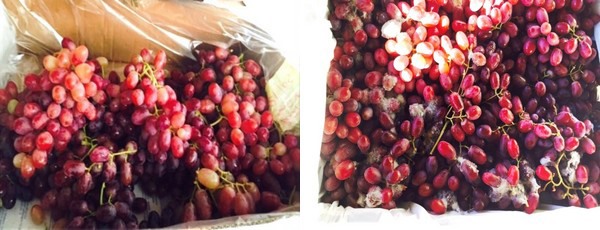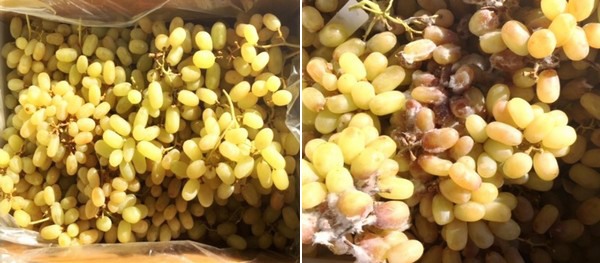There are various options available on the market to extend the shelf life and keep table grapes fresh. One company has combined two methods and can store grapes in very good condition with reduced dry stem for up to 100 days .
Australian company BIOPAC specialises in extending the post-harvest shelf life off fruits, vegetables and flowers .
“We combine two different technologies, the first is a MAP bag, a modified atmosphere bag specially made for table grapes which reduces the oxygen, increases CO2, controls humidity to reach an equilibrium to slow down the respiration rate of the grapes, which translates in more shelf life. In addition to this, to control botrytis, we use an SO2 pad dual release, a combination of a fast release of high level of sulphur dioxide followed by the slow release of low level of sulphur dioxide. Stored at 0 degrees we can achieve up to 100 days shelf life, depending on varieties," explains Antar Douadi from BIOPAC.

Red grapes stored in MAP bags with SO2 pad compared with only SO2 pads
The fruit has to be precooled and the bags must be sealed, but if you need this long storage for export or the domestic market is it a great way to extend the shelf life and quality, according to Antar.
The 100 days can be extended but it does depend greatly on the variety of the grapes. Some grape varieties have a better shelf life than others, so each variety has to be tested. BioPac does it with Crimson, Red Globe, Thompson and also on new varieties such as Sapphire
This method is beneficial for exporting to far off destinations and gives a lot of flexibility for the domestic market.
“If you are using only SO2 pads, after 6 to 8 weeks of storage the quality and taste of the grapes can be affected. For the same period of storage using an MAP bag combined with an SO2 pad the grapes are in much better condition with green stems, firmer berries and better taste. For a longer storage period of 8-14 weeks using only an SO2 pad, it can be very challenging to keep good quality, while when combining it with a MAP bag it can be done under the right controlled temperature management."

White grapes stored in MAP bags with SO2 pad compared with only SO2 pads
Sulphur dioxide has been used for botrytis on grapes worldwide for a long time as has MAP technology, the idea is just to put them together.
“The MAP bags cost more than the industry standard bags which are commonly used but if you can keep premium grapes in top condition, reduce claims, open new markets and get a better price for the product then it is a good investment.”
Growers in Australia are already using the combined technology and growers overseas are also starting to use it. BIOPAC are doing some testing in California with a major grower.
“The aim is not to extend the 70 days storage time that they are already getting using only sulphur dioxide but mostly to improve the overall quality of the grapes upon arrival in the market or while in storage, because after 70 days the quality of the grapes is not optimum."
For more information:
Antar Douadi
BIOPAC Pty Ltd
Tel : +61 (0) 7 5520 4171
info@biopac.com.au
www.biopac.com.au
